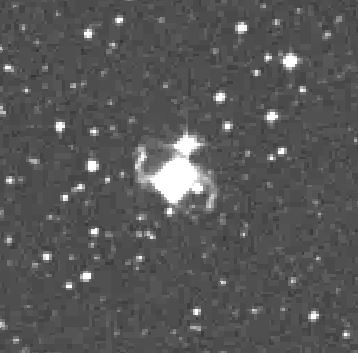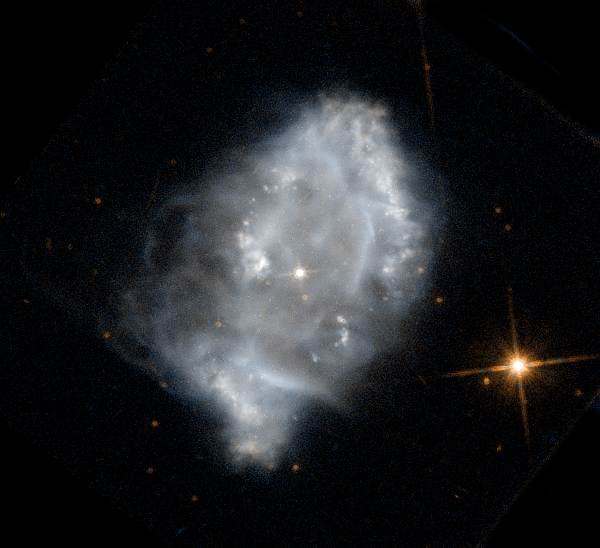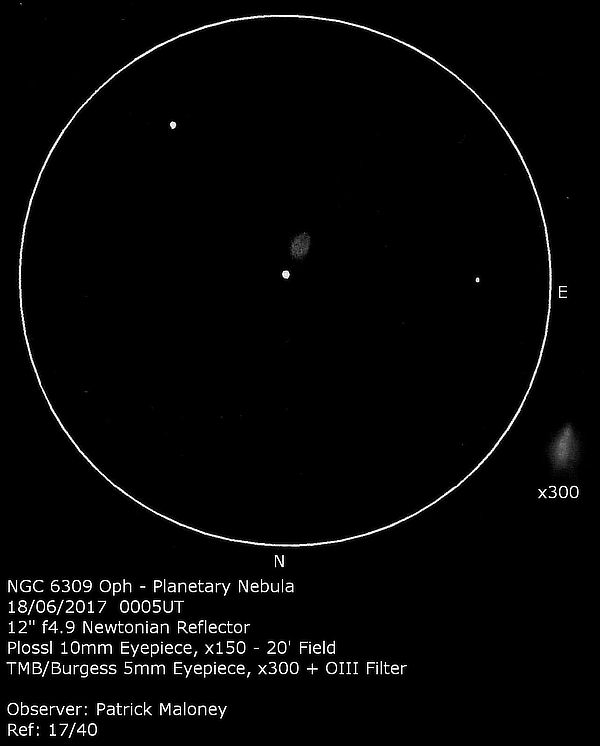NGC 6309 in Ophiuchus
June 2024 - Nebula and Cluster of the Month
Here we are again, in the time of the lightest and shortest of nights. It’s not great for visual astronomy, but as most of us live under the perpetual twilight of light pollution, there’s no good excuse not to get out and have a look. If you are plagued by ever-bright skies anyway, it can be difficult to detect that the Sun is contributing some of the brightness in the sky.
One type of object that is surprisingly good at punching through bright skies is the planetary nebula. Now planetary nebulae come in all shapes and sizes, and I’m not saying that all planetary nebulae are like this, but the smaller, more compact ones generally are. So this month, I’m going to provide a target that you at least have a chance of seeing through the glow – though it won’t necessarily be easy.
NGC 6309 was discovered in 1876 by Wilhelm Tempel (1821—1889). Tempel was a prolific observer, discovering 21 comets, six asteroids and several galaxies. He published his discovery of what was to become NGC 6309 in 1878.
Photographs and images reveal the object to have a very unusual shape. The blue plates from the Palomar survey show a rectangular object, tilted at 45° from north-south, placing one corner of the rectangle at each cardinal point. From the eastern corner, an arm extends and curves up towards the north, whilst from the western corner, an arm extends and curves down towards the south.

This peculiar shape is down to the convoluted history of the nebula. A study by G. Rubio et al published in 20151 shows that the first calculable event in the life story of this object was a mass ejection from the central star about 150,000 years ago. This created a large structure which is detectable today by the presence of two diffuse blobs of material, positioned some 55” and 78” from the centre. The central star is surrounded by a halo of material, 60” in diameter, which must have formed no later than 46,000 years ago, whilst an inner ring and the quadrupolar outflow that now defines the rectangle probably date from about 4,000 years ago. A complex object indeed.

Little of this structure is available to the visual observer. The rectangular shape has been reported, but most observers (including myself) see it simply as elongated. I am not aware of any visual sightings of the ‘arms’.
It seems widely reported that the central star is of magnitude 13. The Deep-Sky Field Guide to Uranometria gives this figure, and Kepple and Sanner’s The Night Sky Observer’s Guide – Volume 2 states that in 8—10” telescopes ...its magnitude 13 central star [is] intermittently visible.
I would dispute that. Images of the nebula clearly show a 12th-magnitude star just to the north of the nebula – this is bright and easily seen. To the south-west is a 15th-magnitude star, which is very difficult with a 12” telescope – I have never seen it. The central star, when visible on images, can be clearly seen to be much fainter than this 15th-magnitude star. The UCAC3 plots a star in the centre of the nebula and assigns it a magnitude of 16.83, which seems far more realistic. The catalogue number of the star is 3UC155-173189.

NGC 6309 lies in Ophiuchus, in a rather barren patch of sky 1.6° west of fourth-magnitude ν Ophiuchi. Once located, it presents as small and moderately bright. It initially appears round, but a little patience (or a higher power) will reveal an elongation in the same direction as the long axis of the rectangle, 45° from north-south. With an OIII filter in place, the nebula becomes brighter and some structure can be made out. It can be seen to be brighter in the middle and an area of faint outer nebulosity appears. There is a brighter spot at its southern edge. With the OIII filter in place, the 12th-magnitude star to the object’s north is not visible.
A challenge, then, for these over-light nights. Best of luck hunting it down.
| Object | RA | Dec | Type | Magnitude |
|---|---|---|---|---|
| NGC 6309 | 17h 41m 04s | -12° 54’ 38” | Planetary nebula | 11.5 |
References:
- ‘NGC 6309, a planetary nebula that shifted from round to multipolar’, Monthly Notices of the Royal Astronomical Society, Volume 446, Issue 11 January 2015, pages 1931-1938 https://doi.org/10.1093/mnras/stu2201